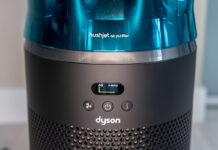 Do you remember when the big phone company slogan was “Reach out and touch someone?” Times have definitely changed since that campaign came out in 1987, Now smartphones have come along, and talking on the phone has became a completely mobile, and in some cases, face-to-face experience.
Do you remember when the big phone company slogan was “Reach out and touch someone?” Times have definitely changed since that campaign came out in 1987, Now smartphones have come along, and talking on the phone has became a completely mobile, and in some cases, face-to-face experience.
That doesn’t mean everyone has given up the reliable landline though. Mobile networks can go down on occasion, and unless you have a phone bundle, your mobile minutes will go through the roof if you sit down and have a long talk on your mobile or smartphone.
It can be hard to sit down and listen to a cell phone too, and cell phones aren’t easy to pick up and hold for long periods of time. I’ve lost my ear buds a few times and tried to tuck a cell phone under my ear while walking and talking—it’s impossible not to drop it.
But the main reason why talking on a cell phone isn’t the greatest is the sound quality; cell phones aren’t designed to overcome issues like loud households. You need a phone designed to be loud, clear, and with no interference, and that’s where Clarity phones come in.
Clarity phones are designed for people with hearing, vision, or other health challenges. The company has been designing communication products with these challenges in mind for 40 years, and in 2005 became the first company to integrate the digital sound processing from hearing aids right into a standard phone.
I plugged a few of the phones from Clarity’s lineup into my landline this past week and tried them out. Here’s what I discovered:
Clarity P300 Amplified Phone with PicturePerfect Dialing

When I plugged the Clarity P300 in my first thought was how perfect this phone was for little kids who want to make a call to a relative but don’t know the number. The PicturePerfect Dialing Pad has 9 programmable direct dial buttons above the regular dialing pad to place photos of people or spots you regularly call, and all you have to do is touch the button and you’ll be connected.
The Clarity P300 is a plug in phone with a corded handset, and it has extra large buttons with large numbers in case you have vision issues. Both the ringer volume and the pitch are adjusted by a slide bar at the bottom of the phone, so you can turn it up and down easily.
If you pick it up and make a call, the volume of the person on the other end is quite loud, and anyone with hearing issues should be able to hear the person on the other end quite clearly. The ringer is very loud too—so much so that I could hear it ringing where it was plugged in upstairs and I was downstairs.
 Clarity Amplified Corded/Cordless Combo with Answering Machine
Clarity Amplified Corded/Cordless Combo with Answering Machine
One of the pitfalls of new technology is when you lose power and suddenly have no phone. That’s why the Clarity E814 is such a handy phone to have around. You get the benefit of a corded handset, a cordless phone, and a built-in answering machine.
Both phones have large buttons, the cordless has backlit keys for when you’re dialing in the dark, and the volume of the call is extra loud for those who may have trouble hearing. The handset can actually amplify sound up to 40 decibels, and when you hit boost, you get another slowly building surge of volume.
The Clarity E814 is easy to set up. For the corded handset, all you need to do is plug it into a jack. It has an A/C plug in for the digital answering machine, but you don’t need the plug in to use the corded handset.
The cordless handset also plugs into any jack but requires power to work. It’s an easy to use handset with call display, up to 35 decibels of amplification, and an adjustable tone control button on the side. The boost button makes it easy to hear if you’re on a call and it’s not loud enough, and the answering machine has simple buttons to playback, fast forward, rewind, or delete messages.
 Clarity Professional XLC3.4 DECT 6.0 Extra Loud Big Button Speakerphone with Talking Caller ID
Clarity Professional XLC3.4 DECT 6.0 Extra Loud Big Button Speakerphone with Talking Caller ID
All it takes is a few uses of new cordless phone to see how cordless phones have changed over the past few years, and the Clarity Professional XLC3.4 is the perfect example of that.
This phone is easy to set up and easy to use, with an extra loud ringer and large, back-lit buttons. You know how some cordless phones have interference and buzzing in the background when you use them? I tried the Clarity XLC3.4 a few times and it was the clearest cordless phone I’ve ever tried. There was no interference at all, and that’s impressive considering our other cordless phone picks up the neighbor’s calls all the time. It’s the DECT 6.0 technology built-in to the phone that makes every call crystal clear, and it was so nice not to hear the interference kick up as I wandered through the house.
If the call isn’t loud enough, you can use the scroll button on the side of the phone to turn it up. The phone also has boost to turn the volume up right on the handset and it’s compatible with certain hearing aids. To use that feature, you just have to tap a button on the phone. It also has Talking Caller ID, so whoever is calling will be announced to you.
One of the nicest features on the phone is the Wi-Fi ClarityLogic set up. If you need help setting up the phone and you’re hooked up to your home’s Wi-Fi network, experts from Clarity can set up your phone remotely or help you with any problems you may have.
Yes, technology has changed and developed smartphones and other mobile phones for portable use, but if Clarity phones are any indication, corded and cordless phones have come a long way. They’re clear, interference free, and loud enough for people with hearing issues.
Clarity phones have practical purposes for anyone who needs a great phone for their landline. Check out Clarity phones and other corded and cordless phones online at Best Buy now.



